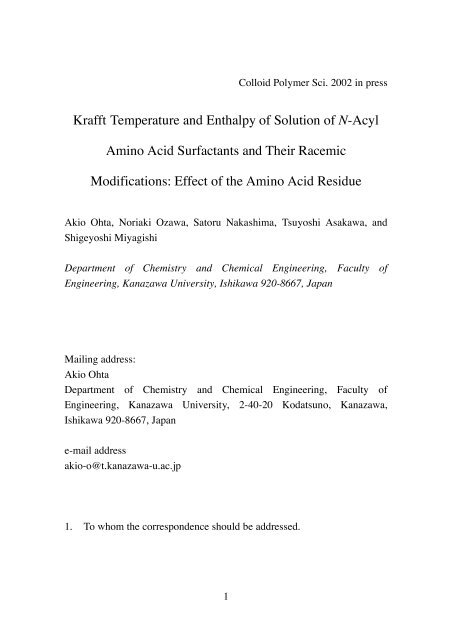Title Krafft temperature and enthalpy of solution of N-acyl amino acid ...
Title Krafft temperature and enthalpy of solution of N-acyl amino acid ... Title Krafft temperature and enthalpy of solution of N-acyl amino acid ...
1 Colloid Polymer Sci. 2002 in press Krafft Temperature and Enthalpy of Solution of N-Acyl Amino Acid Surfactants and Their Racemic Modifications: Effect of the Amino Acid Residue Akio Ohta, Noriaki Ozawa, Satoru Nakashima, Tsuyoshi Asakawa, and Shigeyoshi Miyagishi Department of Chemistry and Chemical Engineering, Faculty of Engineering, Kanazawa University, Ishikawa 920-8667, Japan Mailing address: Akio Ohta Department of Chemistry and Chemical Engineering, Faculty of Engineering, Kanazawa University, 2-40-20 Kodatsuno, Kanazawa, Ishikawa 920-8667, Japan e-mail address akio-o@t.kanazawa-u.ac.jp 1. To whom the correspondence should be addressed.
Abstract The Krafft temperatures and the enthalpies of solution of six kinds of N-hexadecanoyl amino acid surfactant (Gly, Ala, Val, Leu, Ile, and Phe) were obtained from both solubility measurements and differential scanning calorimetry. It was shown that the Krafft temperature of N-hexadecanoyl amino acid surfactant increased with decreasing size of the amino acid residue except for the case of phenylalanine. On the other hand, the enthalpy of solution was endothermic and increased with decreasing size of the amino acid residue except for the cases of glycine and phenylalanine. It was found from these results that the D-L interaction was superior to the L-L interaction in solid state of N-hexadecanoyl amino acid surfactant salt for both the alanine and phenylalanine systems. It was suggested by ab initio calculations that the difference of the magnitude of the peptide-peptide hydrogen bonding was dominant factor for the chiral effect. Keywords N-Acyl amino acid surfactant • Krafft temperature • Enthalpy of solution • Amino acid residue • Chiral effect Introduction N-Acyl amino acid surfactants, which are anionic amino acid-type surfactants, are of immense importance both from the industrial and the domestic viewpoints because of their biodegradability and low toxicity [1]. Micelle formation is an important property of surfactants, and has been the subject of intense research [2-8]. The aggregation number of a micelle is same order as that for general anionic surfactants (ca. 40~100) and 2
- Page 4 and 5: increases with increasing concentra
- Page 6 and 7: mM. After the samples reached equil
- Page 8 and 9: similar result to those obtained fr
- Page 10 and 11: the DL-forms of C16-Val, -Leu, and
- Page 12: simplification of calculation in th
- Page 16 and 17: H 3C C H 2 O 14 N H R O OH amino ac
- Page 18 and 19: 2 1.5 Heat flow / mW 1 0.5 DL-Leu L
- Page 20 and 21: cmc / mM 0.025 0.02 0.015 0.01 3 2
1<br />
Colloid Polymer Sci. 2002 in press<br />
<strong>Krafft</strong> Temperature <strong>and</strong> Enthalpy <strong>of</strong> Solution <strong>of</strong> N-Acyl<br />
Amino Acid Surfactants <strong>and</strong> Their Racemic<br />
Modifications: Effect <strong>of</strong> the Amino Acid Residue<br />
Akio Ohta, Noriaki Ozawa, Satoru Nakashima, Tsuyoshi Asakawa, <strong>and</strong><br />
Shigeyoshi Miyagishi<br />
Department <strong>of</strong> Chemistry <strong>and</strong> Chemical Engineering, Faculty <strong>of</strong><br />
Engineering, Kanazawa University, Ishikawa 920-8667, Japan<br />
Mailing address:<br />
Akio Ohta<br />
Department <strong>of</strong> Chemistry <strong>and</strong> Chemical Engineering, Faculty <strong>of</strong><br />
Engineering, Kanazawa University, 2-40-20 Kodatsuno, Kanazawa,<br />
Ishikawa 920-8667, Japan<br />
e-mail address<br />
akio-o@t.kanazawa-u.ac.jp<br />
1. To whom the correspondence should be addressed.



